Cooling Effect of Urban Blue and Green Spaces: A Case Study of Changsha, China
Abstract
:1. Introduction
2. Materials and Methods
2.1. Study Area
2.2. Landsat Image Collection
2.3. Definition of the Cooling Island Effect of Blue–Green Space
2.4. Statistical Analysis
3. Results and Discussion
3.1. Cooling Effect of Green Spaces
3.2. Cooling Effect of Blue Spaces
3.3. Discussion
4. Conclusions
Author Contributions
Funding
Institutional Review Board Statement
Informed Consent Statement
Data Availability Statement
Acknowledgments
Conflicts of Interest
Appendix A
| Number | Area (ha) | LSI | CI_D (m) | CI_M (°C) | Number | Area (ha) | LSI | CI_D (m) | CI_M (°C) |
| 1 | 1.02 | 1.11 | 80 | 1.69 | 28 | 2.23 | 1.24 | 150 | 1.25 |
| 2 | 1.02 | 1.10 | 90 | 1.87 | 29 | 2.26 | 1.16 | 170 | 2.09 |
| 3 | 1.03 | 1.06 | 30 | 0.84 | 30 | 2.45 | 1.10 | 150 | 2.40 |
| 4 | 1.04 | 1.09 | 120 | 1.93 | 31 | 2.70 | 1.66 | 210 | 1.91 |
| 5 | 1.05 | 1.32 | 140 | 1.83 | 32 | 2.73 | 1.15 | 210 | 1.93 |
| 6 | 1.08 | 1.32 | 110 | 1.30 | 33 | 2.87 | 1.14 | 150 | 1.16 |
| 7 | 1.11 | 1.19 | 90 | 1.15 | 34 | 3.05 | 1.15 | 200 | 2.51 |
| 8 | 1.11 | 1.39 | 120 | 1.64 | 35 | 3.21 | 1.16 | 160 | 1.71 |
| 9 | 1.20 | 1.07 | 150 | 1.57 | 36 | 3.23 | 1.38 | 180 | 1.63 |
| 10 | 1.22 | 1.09 | 120 | 1.18 | 37 | 3.40 | 1.69 | 160 | 2.04 |
| 11 | 1.29 | 1.10 | 60 | 0.70 | 38 | 3.45 | 1.32 | 250 | 1.54 |
| 12 | 1.35 | 1.38 | 140 | 1.57 | 39 | 3.51 | 1.29 | 210 | 2.23 |
| 13 | 1.36 | 1.31 | 160 | 1.41 | 40 | 3.56 | 1.52 | 220 | 2.06 |
| 14 | 1.43 | 1.17 | 100 | 1.18 | 41 | 3.59 | 1.33 | 190 | 2.01 |
| 15 | 1.47 | 1.06 | 90 | 1.40 | 42 | 3.80 | 1.24 | 230 | 2.05 |
| 16 | 1.47 | 1.24 | 90 | 1.82 | 43 | 3.93 | 1.44 | 210 | 2.38 |
| 17 | 1.48 | 1.42 | 110 | 1.88 | 44 | 4.96 | 1.61 | 270 | 1.97 |
| 18 | 1.48 | 1.08 | 120 | 0.87 | 45 | 5.07 | 1.19 | 230 | 1.87 |
| 19 | 1.55 | 1.07 | 100 | 1.00 | 46 | 5.31 | 1.39 | 270 | 2.87 |
| 20 | 1.63 | 1.33 | 150 | 2.01 | 47 | 5.58 | 1.49 | 270 | 2.95 |
| 21 | 1.72 | 1.07 | 140 | 1.06 | 48 | 5.97 | 1.50 | 240 | 2.59 |
| 22 | 1.74 | 1.10 | 150 | 1.65 | 49 | 6.34 | 1.54 | 240 | 1.97 |
| 23 | 1.84 | 1.14 | 150 | 1.80 | 50 | 8.82 | 1.47 | 290 | 2.52 |
| 24 | 1.97 | 1.18 | 120 | 1.53 | 51 | 9.93 | 1.57 | 340 | 3.54 |
| 25 | 2.03 | 1.65 | 150 | 1.86 | 52 | 11.49 | 1.93 | 240 | 3.41 |
| 26 | 2.06 | 1.13 | 120 | 1.39 | 53 | 14.64 | 2.97 | 330 | 3.18 |
| 27 | 2.16 | 1.39 | 200 | 2.43 | Average | 3.15 | 1.32 | 169.25 | 1.85 |
| Number | Area (ha) | LSI | CI_D (m) | CI_M (°C) | Number | Area (ha) | LSI | CI_D (m) | CI_M (°C) |
| 1 | 1.01 | 1.06 | 63.75 | 0.73 | 15 | 2.07 | 1.30 | 148.75 | 1.32 |
| 2 | 1.03 | 1.13 | 86.25 | 1.02 | 16 | 2.07 | 1.30 | 148.75 | 1.32 |
| 3 | 1.03 | 1.54 | 90.00 | 1.83 | 17 | 2.09 | 1.05 | 180.00 | 1.00 |
| 4 | 1.06 | 1.16 | 110.00 | 1.18 | 18 | 2.31 | 1.58 | 180.00 | 1.96 |
| 5 | 1.11 | 1.65 | 151.25 | 1.81 | 19 | 2.63 | 1.06 | 180.00 | 1.98 |
| 6 | 1.16 | 1.23 | 158.75 | 1.66 | 20 | 2.63 | 1.11 | 150.00 | 1.48 |
| 7 | 1.21 | 1.09 | 110.00 | 1.54 | 21 | 3.37 | 1.08 | 190.00 | 2.44 |
| 8 | 1.21 | 1.19 | 150.00 | 1.26 | 22 | 4.18 | 1.11 | 147.50 | 2.35 |
| 9 | 1.30 | 1.15 | 122.50 | 1.34 | 23 | 4.46 | 1.67 | 240.00 | 2.07 |
| 10 | 1.34 | 1.50 | 150.00 | 1.16 | 24 | 5.05 | 1.06 | 202.50 | 2.59 |
| 11 | 1.56 | 1.06 | 150.00 | 1.37 | 25 | 5.70 | 1.75 | 270.00 | 3.05 |
| 12 | 1.76 | 1.20 | 130.00 | 1.52 | 26 | 10.96 | 1.58 | 278.75 | 3.04 |
| 13 | 1.93 | 1.17 | 210.00 | 3.07 | 27 | 24.09 | 1.48 | 337.5 | 4.92 |
| 14 | 2.03 | 1.27 | 210.00 | 2.00 | 28 | 29.99 | 1.52 | 370.00 | 5.04 |
| Average | 4.30 | 1.29 | 175.58 | 2.00 |
References
- Arnfield, A.J. Two decades of urban climate research: A review of turbulence, exchanges of energy and water, and the urban heat Island. Int. J. Climatol. 2003, 23, 1–26. [Google Scholar] [CrossRef]
- Forman, R.T. Urban Ecology: Science of Cities; Cambridge University Press: New York, NY, USA, 2014. [Google Scholar]
- Laschewski, G.; Jendritzky, G. Effects of the thermal environment on human health: An investigation of 30 years of daily mortality data from SW Germany. Clim. Res. 2002, 21, 91–103. [Google Scholar] [CrossRef]
- Chen, H.; Goldberg, M.S. The effects of outdoor air pollution on chronic illnesses. Mcgill J. Med. 2009, 12, 58–64. [Google Scholar] [CrossRef]
- Luan, G.; Yin, P.; Li, T.; Wang, L.; Zhou, M. The years of life lost on cardiovascular disease attributable to ambient temperature in China. Sci. Rep. 2017, 7, 13531. [Google Scholar] [CrossRef] [PubMed]
- Kosatsky, T. The 2003 European heat waves. Eurosurveillance 2005, 10, 3–4. [Google Scholar] [CrossRef]
- De Blois, J.; Kjellstrom, T.; Agewall, S.; Ezekowitz, J.A.; Armstrong, P.W.; Atar, D. The effects of climate change on cardiac health. Cardiology 2015, 131, 209–217. [Google Scholar] [CrossRef]
- Zhang, Q.; Wu, Z.; Singh, V.P.; Liu, C. Impacts of spatial configuration of land surface features on land surface temperature across urban agglomerations, China. Remote Sens. 2021, 13, 4008. [Google Scholar] [CrossRef]
- Bowler, D.E.; Buyung-Ali, L.; Knight, T.M.; Pullin, A.S. Urban greening to cool towns and cities: A systematic review of the empirical evidence. Landsc. Urban Plan. 2010, 97, 147–155. [Google Scholar] [CrossRef]
- Völker, S.; Kistemann, T. Developing the urban blue: Comparative health responses to blue and green urban open spaces in Germany. Health Place 2015, 35, 196–205. [Google Scholar] [CrossRef]
- Cheng, X.; Peng, J.; Dong, J.; Liu, Y.; Wang, Y. Non-linear effects of meteorological variables on cooling efficiency of African urban trees. Environ. Int. 2022, 169, 107489. [Google Scholar] [CrossRef]
- Gascon, M.; Triguero-Mas, M.; Martinez, D.; Dadvand, P.; Forns, J.; Plasencia, A.; Nieuwenhuijsen, M.J. Mental health benefits of long-term exposure to residential green and blue spaces: A systematic review. Int. J. Environ. Res. Public Health 2015, 12, 4354–4379. [Google Scholar] [CrossRef] [PubMed]
- Jáuregui, E. Influence of a large urban park on temperature and convective precipitation in a tropical city. Energy Build. 1990, 15, 457–463. [Google Scholar] [CrossRef]
- Sodoudi, S.; Zhang, H.; Chi, X.; Müller, F.; Li, H. The influence of spatial configuration of green areas on microclimate and thermal comfort. Urban For. Urban Green. 2018, 34, 85–96. [Google Scholar] [CrossRef]
- Cao, X.; Onishi, A.; Chen, J.; Imura, H. Quantifying the cool island intensity of urban parks using ASTER and IKONOS data. Landsc. Urban Plan. 2010, 96, 224–231. [Google Scholar] [CrossRef]
- Feyisa, G.L.; Meilby, H.; Fensholt, R.; Proud, S.R. Automated water extraction index: A new technique for surface water mapping using Landsat imagery. Remote Sens. Environ. 2014, 140, 23–35. [Google Scholar] [CrossRef]
- Gunawardena, K.R.; Wells, M.J.; Kershaw, T. Utilising green and bluespace to mitigate urban heat island intensity. Sci. Total Environ. 2017, 584, 1040–1055. [Google Scholar] [CrossRef]
- Hou, H.; Estoque, R.C. Detecting cooling effect of landscape from composition and configuration: An urban heat island study on Hangzhou. Urban For. Urban Green. 2020, 53, 126719. [Google Scholar] [CrossRef]
- Yang, G.; Yu, Z.; Jørgensen, G.; Vejre, H. How can urban blue-green space be planned for climate adaption in high-latitude cities? A seasonal perspective. Sustain. Cities Soc. 2020, 53, 101932. [Google Scholar] [CrossRef]
- Du, H.; Cai, W.; Xu, Y.; Wang, Z.; Wang, Y.; Cai, Y. Quantifying the cool island effects of urban green spaces using remote sensing data. Urban For. Urban Green. 2017, 27, 24–31. [Google Scholar] [CrossRef]
- Chang, C.R.; Li, M.H.; Chang, S.D. A preliminary study on the local cool-island intensity of Taipei city parks. Landsc. Urban Plan. 2007, 80, 386–395. [Google Scholar] [CrossRef]
- Sun, X.; Tan, X.; Chen, K.; Song, S.; Zhu, X.; Hou, D. Quantifying landscape-metrics impacts on urban green-spaces and water-bodies cooling effect: The study of Nanjing, China. Urban For. Urban Green. 2020, 55, 126838. [Google Scholar] [CrossRef]
- Wang, C.; Ren, Z.; Dong, Y.; Zhang, P.; Guo, Y.; Wang, W.; Bao, G. Efficient cooling of cities at global scale using urban green space to mitigate urban heat island effects in different climatic regions. Urban For. Urban Green. 2022, 74, 127635. [Google Scholar] [CrossRef]
- Yu, Y.; Jianxin, Q.; Shunshi, H. Spatial-temporal evolution of urban heat Island effects in Changsha City. J. Geo-Inf. Sci. 2017, 4, 518–527. [Google Scholar]
- CMA Data Center. China Meteorological Data Service Center. Available online: http://data.cma.cn/ (accessed on 19 August 2020).
- Ye, Q.; Mo, Z.; Xu, Y. The expansion and driving forces of the functional space land: A case study of Changsha from 1979 to 2014. Geogr. Res. 2019, 38, 1063–1079. [Google Scholar]
- Silva, J.S.; da Silva, R.M.; Santos, C.A.G. Spatiotemporal impact of land use/land cover changes on urban heat islands: A case study of Paço do Lumiar, Brazil. Build. Environ. 2018, 136, 279–292. [Google Scholar] [CrossRef]
- Qiu, X.; Kil, S.H.; Park, C. Spatiotemporal contribution of blue-green spaces to the urban thermal environment in Changsha, China. Sens. Mater. 2021, 33, 3709–3727. [Google Scholar] [CrossRef]
- Sun, R.; Chen, A.; Chen, L.; Lü, Y. Cooling effects of wetlands in an urban region: The case of Beijing. Ecol. Indic. 2012, 20, 57–64. [Google Scholar] [CrossRef]
- Yu, K.; Chen, Y.; Liang, L.; Gong, A.; Li, J. Quantitative analysis of the interannual variation in the seasonal water cooling island (WCI) effect for urban areas. Sci. Total Environ. 2020, 727, 138750. [Google Scholar] [CrossRef] [PubMed]
- Tan, X.; Sun, X.; Huang, C.; Yuan, Y.; Hou, D. Comparison of cooling effect between green space and water body. Sustain. Cities Soc. 2021, 67, 102711. [Google Scholar] [CrossRef]
- McGarigal, K. FRAGSTATS: Spatial Pattern Analysis Program for Quantifying Landscape Structure; US Department of Agriculture, Forest Service, Pacific Northwest Research Station: Corvallis, OR, USA, 1995.
- Yu, Z.; Guo, X.; Jørgensen, G.; Vejre, H. How can urban green spaces be planned for climate adaptation in subtropical cities? Ecol. Indic. 2017, 82, 152–162. [Google Scholar] [CrossRef]
- Yu, Z.; Yang, G.; Zuo, S.; Jørgensen, G.; Koga, M.; Vejre, H. Critical review on the cooling effect of urban blue-green space: A threshold-size perspective. Urban For. Urban Green. 2020, 49, 126630. [Google Scholar] [CrossRef]
- Kouhi, E.; Morsi, Y.S. A parametric study on mathematical formulation and geometrical construction of a stentless aortic heart valve. J. Artif. Organs 2013, 16, 425–442. [Google Scholar] [CrossRef] [PubMed]
- Zhang, L.; Gu, T.; Zhao, J.; Ji, S.; Hu, M.; Li, X. An improved moving least squares method for curve and surface fitting. Math. Probl. Eng. 2013, 2013, 159694. [Google Scholar] [CrossRef]
- Lifton, J.J.; Liu, T.; McBride, J. Non-linear least squares fitting of Bézier surfaces to unstructured point clouds. AIMS Math. 2021, 6, 3142–3159. [Google Scholar] [CrossRef]
- Antoszewski, P.; Swierk, D.; Krzyzaniak, M. Statistical review of quality parameters of blue-green infrastructure elements important in mitigating the effect of the urban heat island in the temperate climate (C) zone. Int. J. Environ. Res. Public Health 2020, 17, 7093. [Google Scholar] [CrossRef]
- Sun, R.; Chen, L. How can urban water bodies be designed for climate adaptation? Landsc. Urban Plan. 2012, 105, 27–33. [Google Scholar] [CrossRef]
- Park, J.; Kim, J.-H.; Lee, D.K.; Park, C.Y.; Jeong, S.G. The influence of small green space type and structure at the street level on urban heat island mitigation. Urban For. Urban Green. 2017, 21, 203–212. [Google Scholar] [CrossRef]
- Zeng, Z.; Zhou, X.; Li, L. The impact of water on microclimate in Lingnan area. Procedia Eng. 2017, 205, 2034–2040. [Google Scholar] [CrossRef]
- Lin, H.; Niu, J.; Ma, H.; Fan, Y. Urban water body reduction of heat island effect–A case study of Nanjing City J. J. Xinyang Norm. Univ. 2017, 30, 234–238. [Google Scholar] [CrossRef]
- Yu, Z.; Guo, X.; Zeng, Y.; Koga, M.; Vejre, H. Variations in land surface temperature and cooling efficiency of green space in rapid urbanization: The case of Fuzhou city, China. Urban For. Urban Green. 2018, 29, 113–121. [Google Scholar] [CrossRef]
- Kong, F.; Yin, H.; James, P.; Hutyra, L.R.; He, H.S. Effects of spatial pattern of greenspace on urban cooling in a large metropolitan area of eastern China. Landsc. Urban Plan. 2014, 128, 35–47. [Google Scholar] [CrossRef]
- Cai, Z.; Han, G.; Chen, M. Do water bodies play an important role in the relationship between urban form and land surface temperature? Sustain. Cities Soc. 2018, 39, 487–498. [Google Scholar] [CrossRef]
- Estoque, R.C.; Murayama, Y.; Myint, S.W. Effects of landscape composition and pattern on land surface temperature: An urban heat island study in the megacities of Southeast Asia. Sci. Total Environ. 2017, 577, 349–359. [Google Scholar] [CrossRef] [PubMed]
- Wong, N.H.; Tan, C.L.; Kolokotsa, D.D.; Takebayashi, H. Greenery as a mitigation and adaptation strategy to urban heat. Nat. Rev. Earth Environ. 2021, 2, 166–181. [Google Scholar] [CrossRef]
- Huo, H.; Chen, F.; Geng, X.; Tao, J.; Liu, Z.; Zhang, W.; Leng, P. Simulation of the urban space thermal environment based on computational fluid dynamics: A comprehensive review. Sensors 2021, 21, 6898. [Google Scholar] [CrossRef] [PubMed]
- Wang, Y.; Ouyang, W. Investigating the heterogeneity of water cooling effect for cooler cities. Sustain. Cities Soc. 2021, 75, 103281. [Google Scholar] [CrossRef]
- Rotem-Mindali, O.; Michael, Y.; Helman, D.; Lensky, I.M. The role of local land-use on the urban heat island effect of Tel Aviv as assessed from satellite remote sensing. Appl. Geogr. 2015, 56, 145–153. [Google Scholar] [CrossRef]
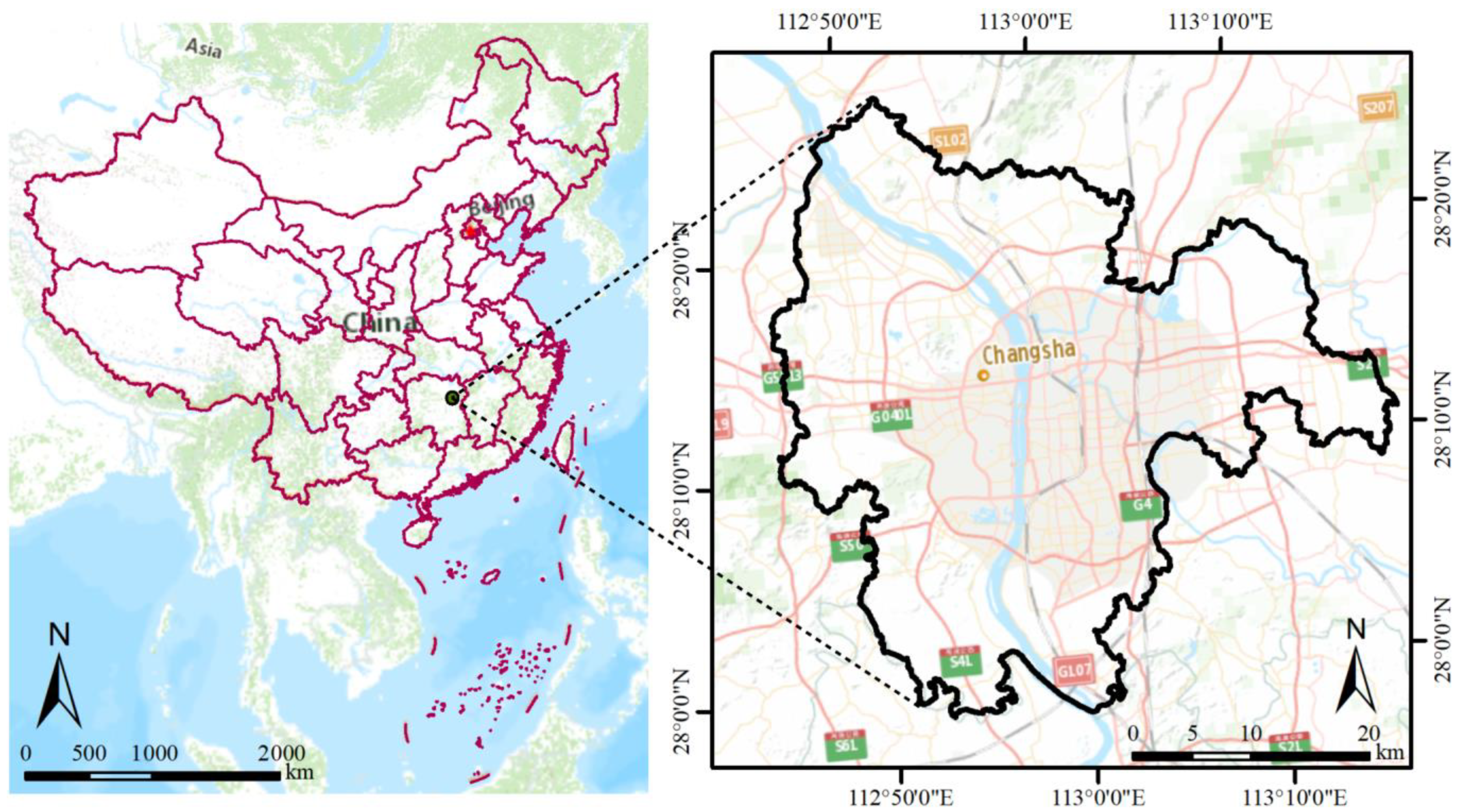
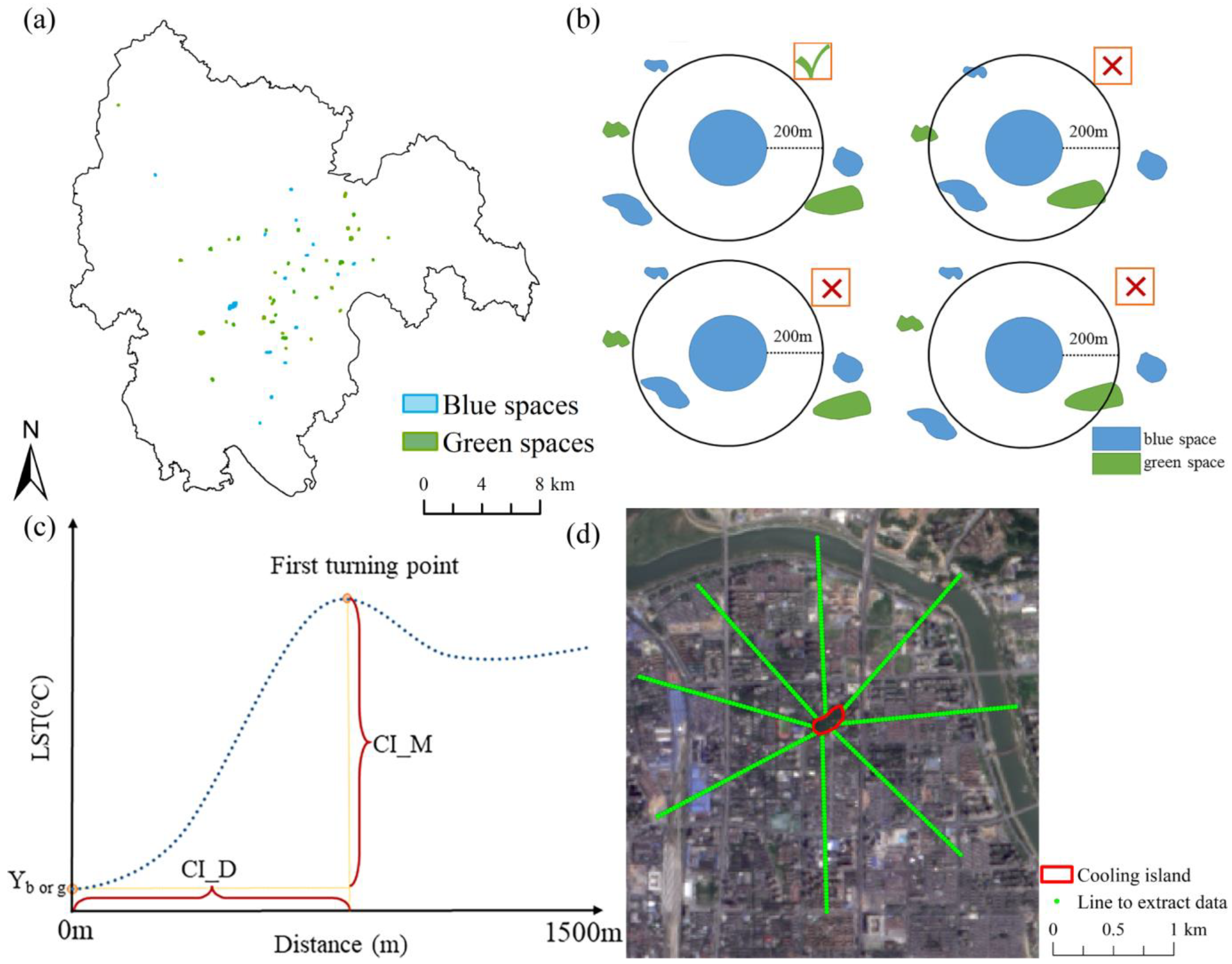
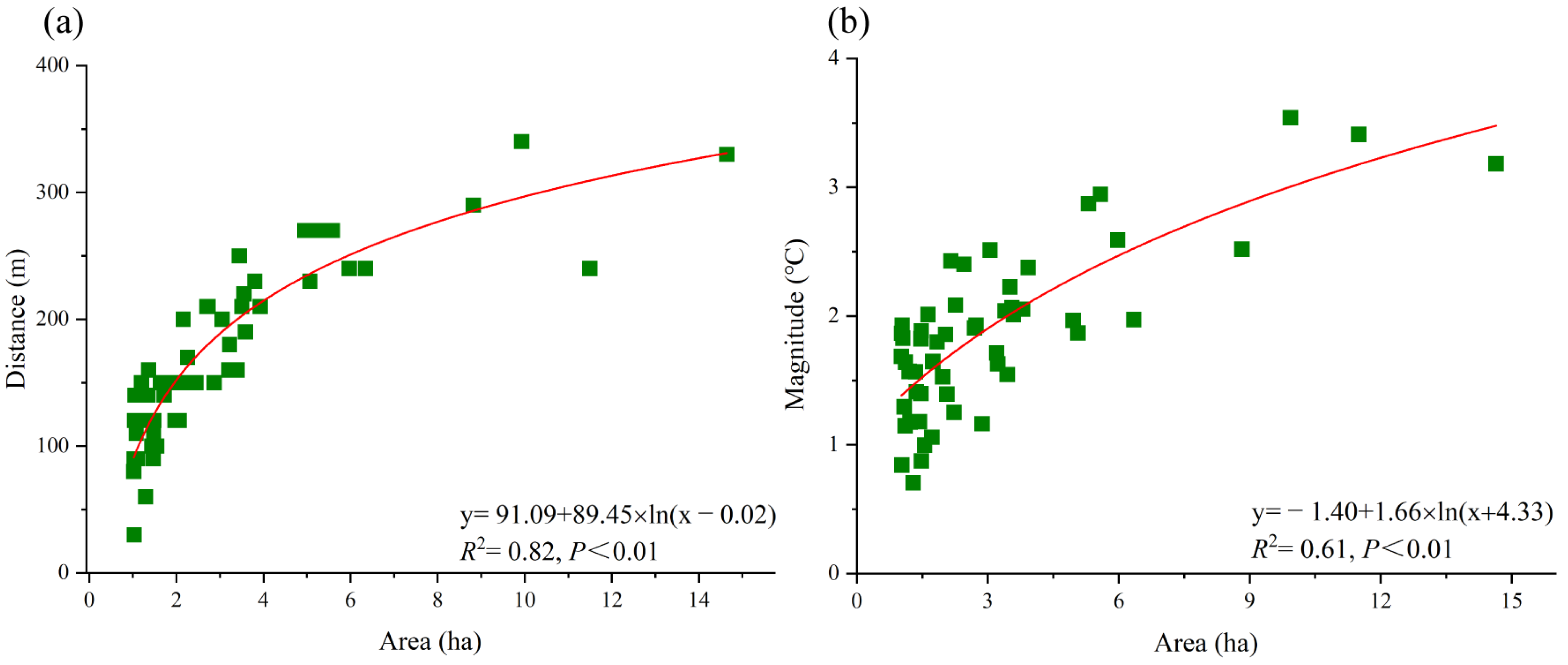
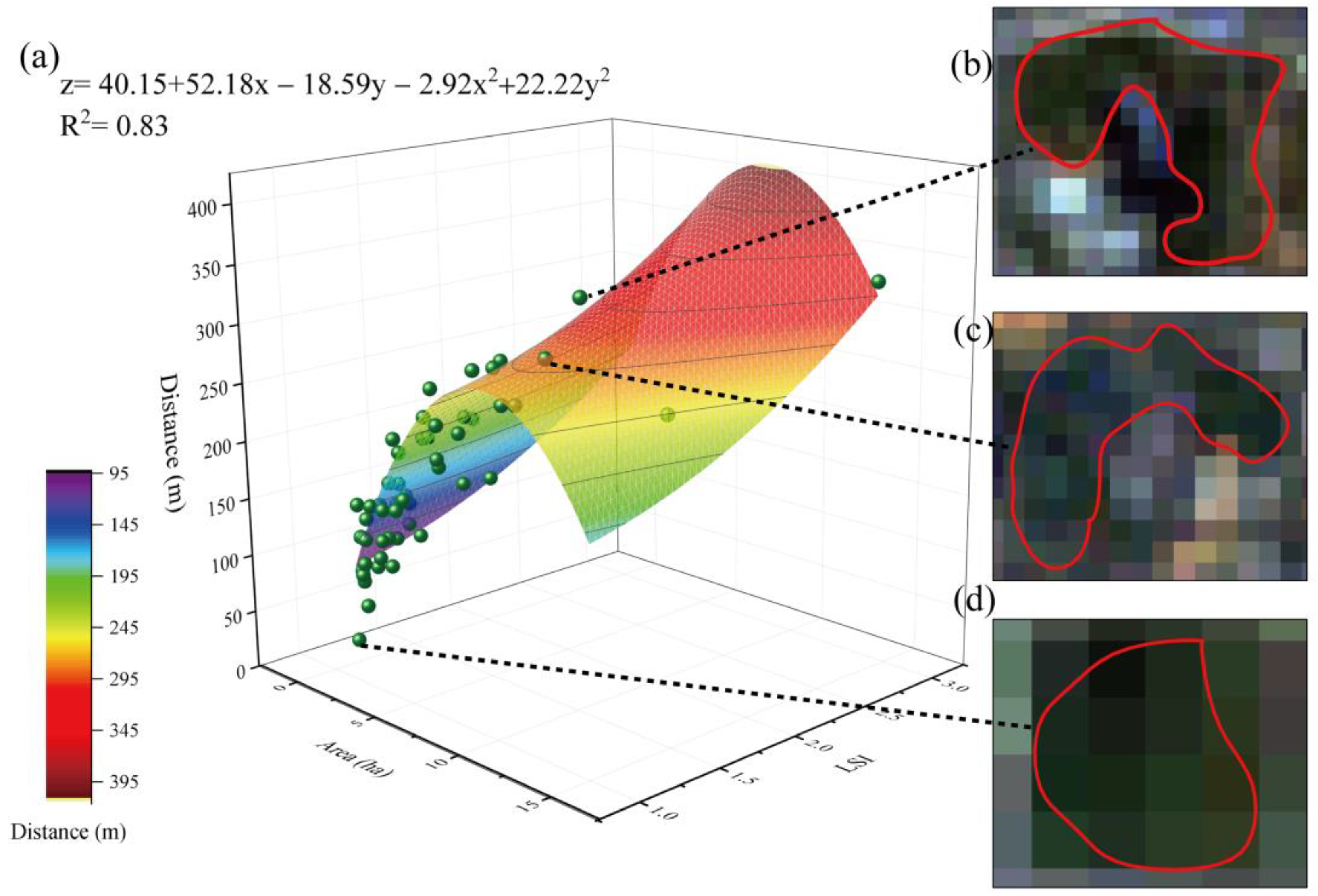
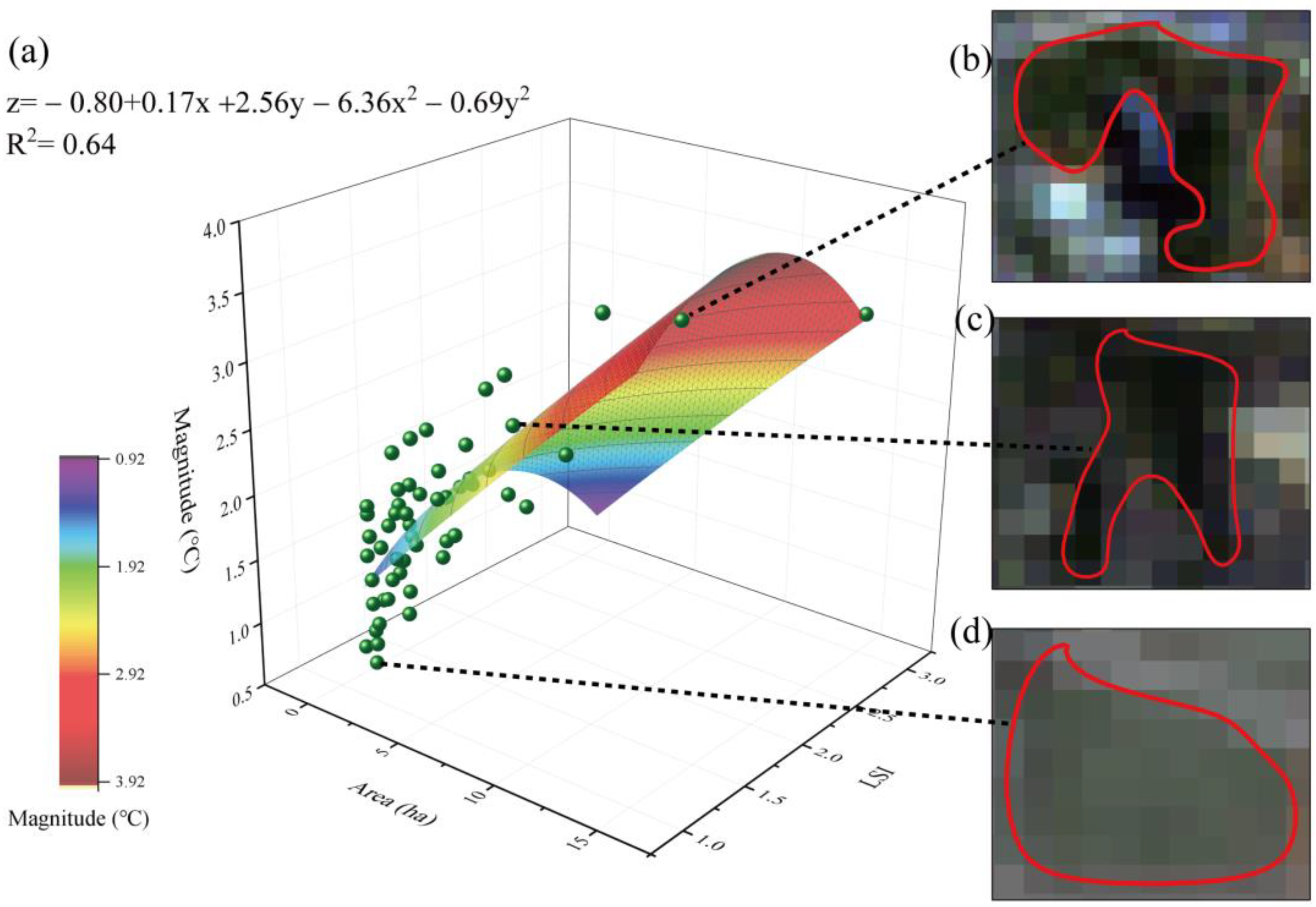
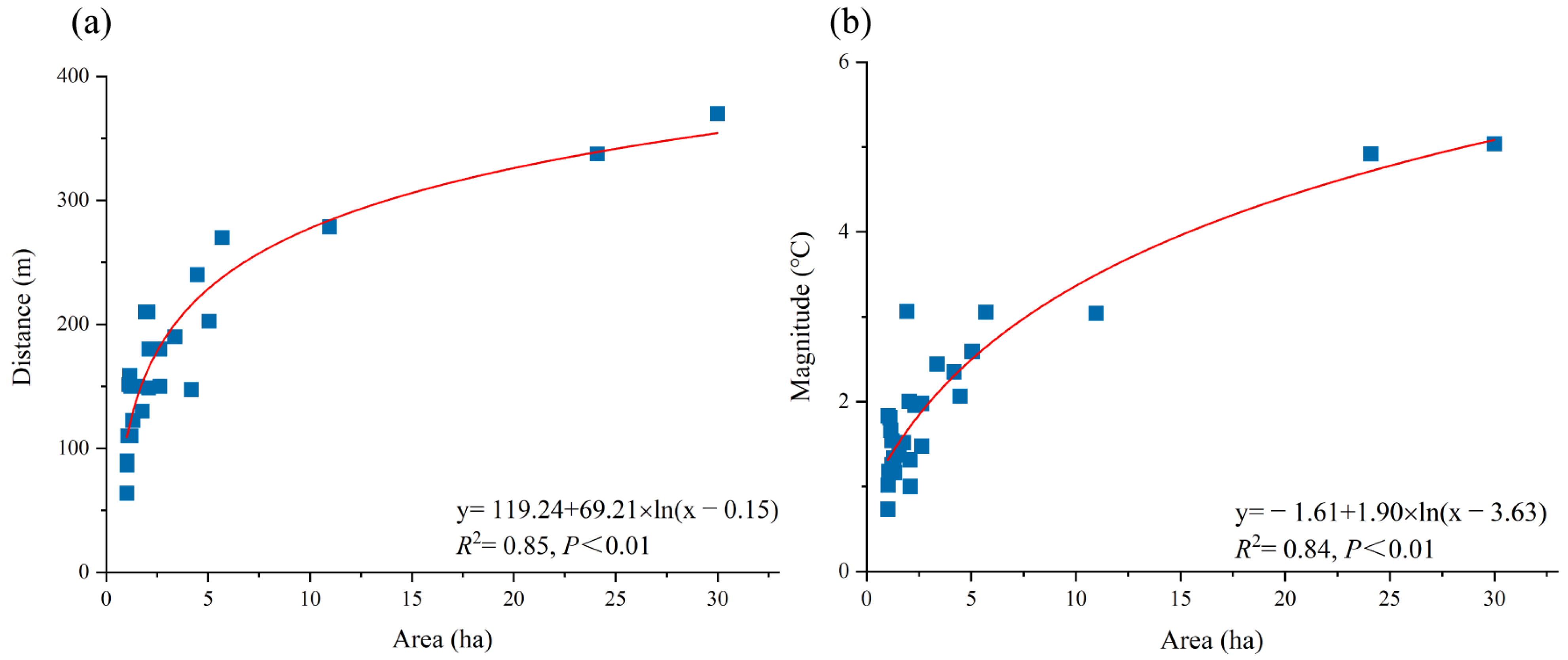
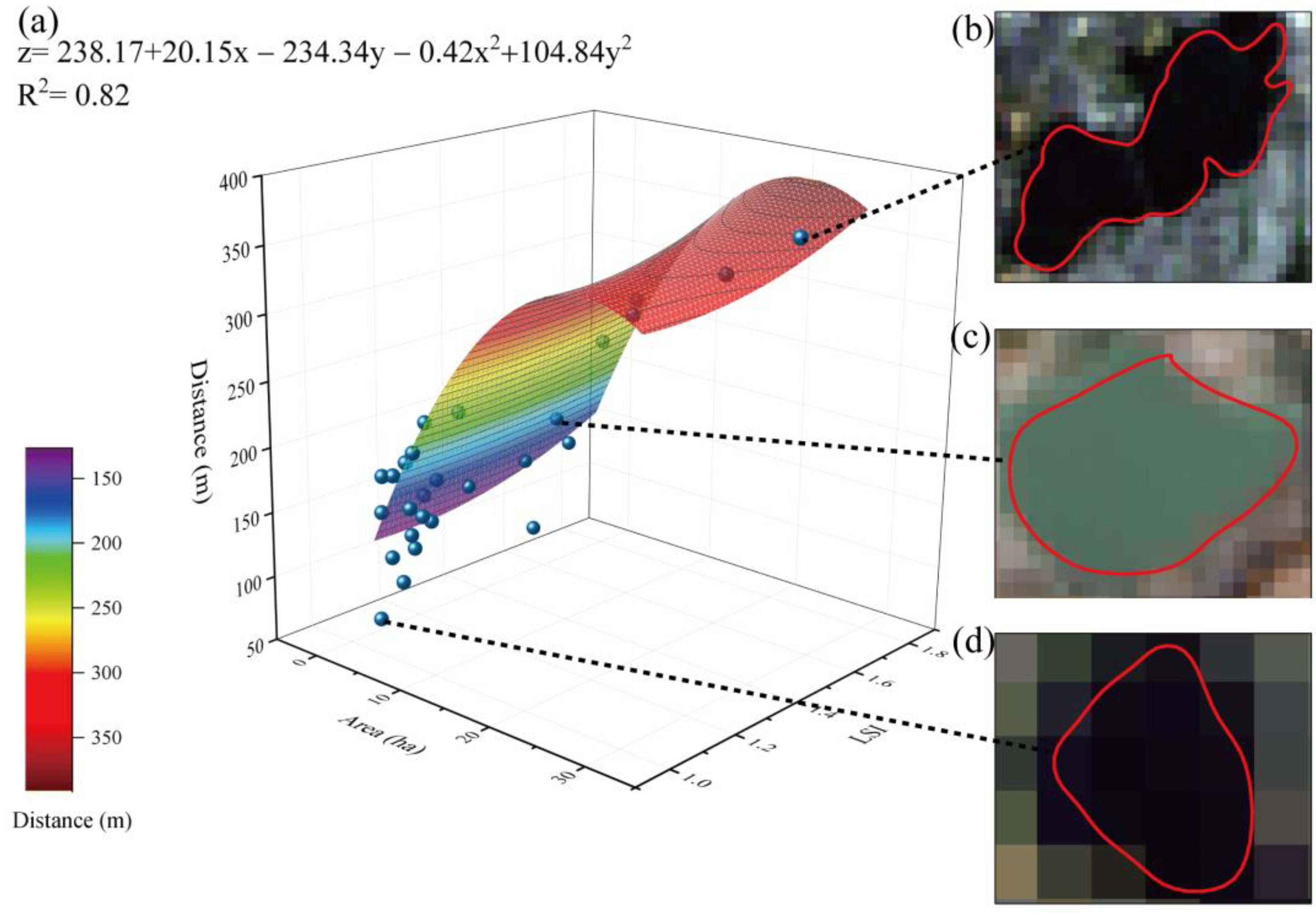
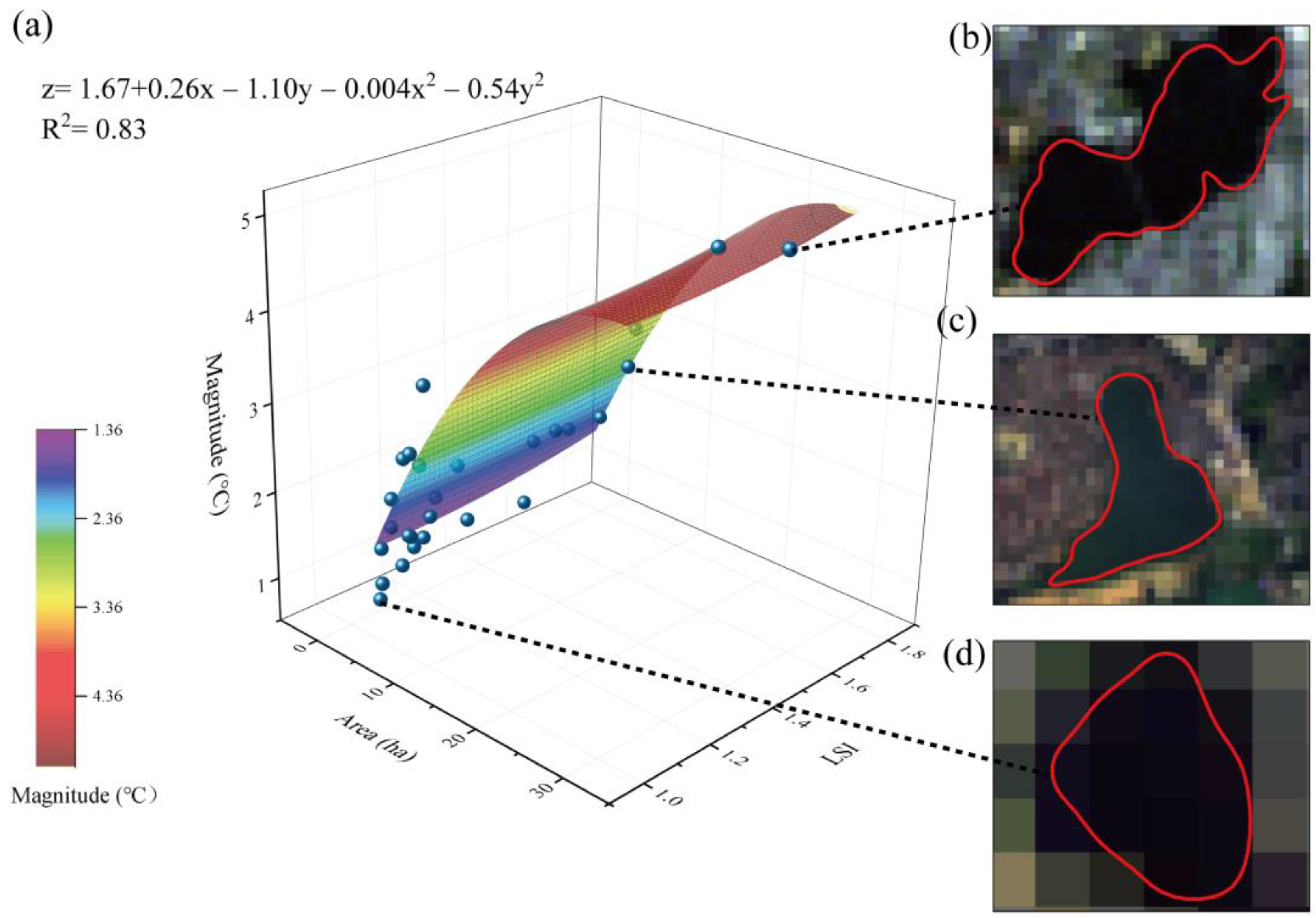
Disclaimer/Publisher’s Note: The statements, opinions and data contained in all publications are solely those of the individual author(s) and contributor(s) and not of MDPI and/or the editor(s). MDPI and/or the editor(s) disclaim responsibility for any injury to people or property resulting from any ideas, methods, instructions or products referred to in the content. |
© 2023 by the authors. Licensee MDPI, Basel, Switzerland. This article is an open access article distributed under the terms and conditions of the Creative Commons Attribution (CC BY) license (https://creativecommons.org/licenses/by/4.0/).
Share and Cite
Qiu, X.; Kil, S.-H.; Jo, H.-K.; Park, C.; Song, W.; Choi, Y.E. Cooling Effect of Urban Blue and Green Spaces: A Case Study of Changsha, China. Int. J. Environ. Res. Public Health 2023, 20, 2613. https://doi.org/10.3390/ijerph20032613
Qiu X, Kil S-H, Jo H-K, Park C, Song W, Choi YE. Cooling Effect of Urban Blue and Green Spaces: A Case Study of Changsha, China. International Journal of Environmental Research and Public Health. 2023; 20(3):2613. https://doi.org/10.3390/ijerph20032613
Chicago/Turabian StyleQiu, Xinyi, Sung-Ho Kil, Hyun-Kil Jo, Chan Park, Wonkyong Song, and Yun Eui Choi. 2023. "Cooling Effect of Urban Blue and Green Spaces: A Case Study of Changsha, China" International Journal of Environmental Research and Public Health 20, no. 3: 2613. https://doi.org/10.3390/ijerph20032613
APA StyleQiu, X., Kil, S.-H., Jo, H.-K., Park, C., Song, W., & Choi, Y. E. (2023). Cooling Effect of Urban Blue and Green Spaces: A Case Study of Changsha, China. International Journal of Environmental Research and Public Health, 20(3), 2613. https://doi.org/10.3390/ijerph20032613







